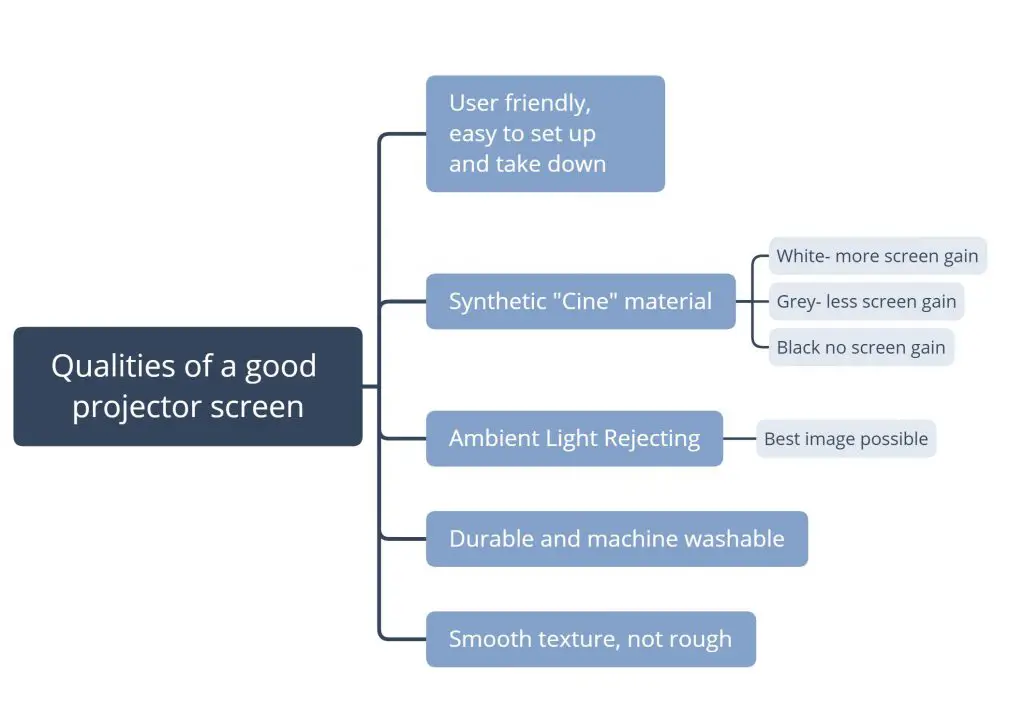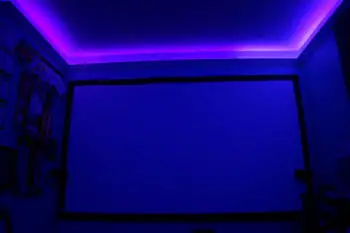Introduction
If you’re new to this website then welcome! This site is all about creating the ultimate home theater, gaming room, and man cave is set up. This site has a ton of resources if you were still in the process of putting together your ideal space. This topic is going to be all about projector screens and how to find a quality product.
There’s a lot of information regarding this topic, but I narrowed down all the essential information for you so you do as little research as possible.
Getting your projector screen right is one of the most important things you can do for your home theater. Quality and material type do matter, and I’ll get into all of those details in the below sections. In this article, I’ll cover why projector screens matter, how to find a good one, the projector screen that I love most, and some other related questions.
Table of Contents
1. Why projector screens matter
2. Qualities of a good screen
3. The projector screen I use
4. Ambient light rejecting screens
5. Good product examples
6. Related Questions
So do projector screens matter?
Projector screens matter because the material type, color, and texture can all affect the quality of the image. The color of your screen will affect how much light will bounce off of it when projecting an image. Dark colors are better such as gray or black because there’s less observed screen gain.
The texture of a screen is important for a couple of reasons. The smoother and finer material will make image quality look sharper. A rough screen will make images look more pixelated and reduce the quality and contrast observed. A white screen is still good, just know that your images will always look brighter than a black screen. I would highly recommend a black screen because you will be able to see better contrast in images, even when the lights are on.

What to look for in a good screen
Below is a brief and easy to understand list of what a good projector screen should have. A lot of these go off of what was mentioned above. This is my checklist for when I browse for movie screens online or in person.
- User-friendly: The first projector screen that I got was extremely easy to set up. It was so simple that I could even dismount it from the wall and carry it outside to set up for outdoor movies. Sometimes I had to take it down and put it back up when adjusting wall decor.
. - CineGrey, White, or Black material. There is a lot of debate over what the best projector screen color is. There is a lot of debate over what the best projector screen color is. I currently use a white one and a bunch of people would say I’m wrong for having that. I love my screen and as long as it is the synthetic Cine material, you can be sure that it is the smoothest and one of the best materials. There is a material type that is a leg above the rest which I will talk about in the next section.
. - Screen gain: No matter what material type and color you go with, make sure you look at the screen gain number in the description of the product. This number is actually important. It tells you how much light will be reflected off the screen with respect to the brightness of the original image. A screen gain of 1.5 will reflect the brightness of the projector by a factor of 1.5x the original length. This number shouldn’t be greater than two otherwise the image will feel too bright. It’s okay if screen gain varies by plus or -.25 on either side of 1. 1 is ideal.
A Projector Screen Needs to be Durable
Even though your screen will likely never change locations once you have it set up, you will still notice that it gets scuffed up in certain areas. Machine washable screens are the best for keeping the longevity of your home theater set up.
Regardless of material type, any good projector screen will be easy to clean and it will be tear-resistant. Dust also collects on the screen over time, and it is necessary to clean and wash it even if it doesn’t look dirty. You’ll notice your image quality increases after washing as well.
- The color of the screen will affect how much light bounces off and reflects off screen
- The texture of the screen matters: finer material is of better quality and leads to better picture quality. Leads to projector maximizing its resolution
- Durability and machine washable is important: wrinkles, scuffs, and dust collect. Going on a little too much of a budget might have you end up with a less durable screen. If it can’t withstand a little bit of a beating or some normal wear and tear, you might be out $80. In that case you would essentially have to buy a new screen (that’s why this aspect of movie screens is important).
. - You also want one that is easy to set up and takedown. If you ever upgrade or need to move some of your other home theater equipment around, you will want easy access to the wall behind your screen. Some people end up putting their speakers behind the projector screen. This creates more space in the front and makes your area feel more spacious.
My Projector Screen
Above is the video review of the projector screen my family uses. This is primarily an indoor screen however, it is great for outdoor theater setups as well. We usually can take it from the inside and set it up outside in under 10 minutes!
The time lapse you see in the video is no more than a few minutes. The entire frame is extremely lightweight and easy to hook up. The material is also very tear resistant, even though it is extremely smooth to the touch.
It is extremely light, machine washable, and I can literally carry this thing all by myself. To make our set up easier we ordered hooks from Home Depot which is what essentially holds the entire screen on the wall. We have three that run across the top. Take a look at the article review if you’re interested in the one that I have.
Before we got this one, we literally used a white blanket sheet with office pins to hold them in place. We didn’t actually consider how much better an actual screen would be until we saw some videos on home theater set ups. We also got a really good projector “link to it here “ Before we got this one, we literally used a white blanket sheet with office pins to hold them in place. We didn’t actually consider how much better an actual screen would be until we saw some videos on home theater set ups.
We also got a really good projector but we knew we weren’t getting the quality we could be just from the projector alone. The purchase of my first dedicated screen showed me how much of a difference this can actually make.
Ambient Light Rejecting Screens
I mentioned in the above section that there is a material that is slightly better than all the rest. ALR screens are able to better reflect and do a couple of other fancy things to make images look better than ever.
- ALR Stands for ambient rejecting. The screen material essentially blocks out ambient light, leaving you with the purest and original projector image. These screens are often higher quality than regular screens. If you are a first time projector screen buyer, then you honestly will be extremely satisfied with A regular projector screen. As long as your projector is 1080P resolution you’ll be good to go.
. - (Put this one in middle). The video below is a snippet of an ALR Frame put up against a regular screen. Immediately, you can notice the difference that this screen material provides.
. - If you’re interested in more information specific to this screen type, check out this article on a complete guide. It has all the information you would want if you are heavily considering purchasing one of these.
. - Contrary to what you might be thinking, I actually have found these screens at fairly reasonable prices. Many of them are close in price to regular screens. I don’t think people consider this feature is often overlooked
.
Good Projector Screens
To make your research a little easier for you, I included some of the projector screens that check all of the boxes we mentioned above. They are also well-reviewed by buyers, but more specifically, they are great entry-level projector screens if you have never used one before. I also kept in mind the simplicity and user-friendly set up feature with all of them.
Elite Screens Sable Frame B2
This one is a great entry level screen because it’s easy to set up and comes with a nice black border finish. 100 inches is a great size. You’ll feel like you’re in the movie or game that’s being projected. It’s priced at $200, a perfectly balanced price. You get the quality you pay for and there’s nothing about this screen that’s adding to the price unnecessarily.
It can even project up to 8k if you get a projector that can display that type of image quality. The first screen you purchase should make it easy to accommodate a projector upgrade. You don’t want to purchase a nicer projector than your first one but not have a screen that can do justice to the improved resolution.
Delux Screens 4k
Delux Screens makes products similar to Elite Screens. I would say these two are rivals nonetheless. I like this model of Delux Screens because there are more customization options available. Elite Screens has more limited customization options when it comes to size, aspect ratio, and material color. I love my white screen, but a CineGrey material will have lower screen gain. Lower screen gain as mentioned earlier reduces the amount of ambient light you have to block out.
You can even order this one as a manual pulldown if you plan to set it up in your living room. Although this model of Delux Screens is more expensive, they also come in larger sizes. For $50 more than the Elite Screens Sable, you can get the Delux Screens model at 135 inches. 35 Inches more makes all the difference and you will definitely appreciate that image size!
Elite Screens Aeon CineGrey ALR
This is as high end as you can get. Anything above the price of this one, and you start to enter a world of diminishing returns. If you haven’t already noticed, Elite Screens and Silver Ticket tend to dominate the market. I tried to find some other good brands, but these two along with Delux Screens always had the better praise. I also have a bias because I’m an Elite Screens buyer and I can attest to all the praise people give this brand of screens.
For this screen specifically, note that it is Ambient Light Rejecting. This is what makes it the more expensive option of the three in this section. This would be the absolute max I recommend spending on a screen. But this option right here is the best one money can buy. See the article on ALR Screens from the section above if you want more useful info.
Related Questions
Are ALR screens more expensive? Not in every case. The ones that are larger than 120 inches tend to get pretty expensive. I found a bunch that were within the 100 to 120 range for a very reasonable price. If I could go back in time, I would have purchased an ALR screen because it was around the same price as the regular elite screens product that I got. “Check out the link to the complete guide“ if you were interested in more information.
How much space do I need for my screen? I strongly recommend you have at least a buffer space of 1 foot in all directions from your screen. You want your wall to have a little bit of breathing space because you’re going to need it for set up. Anything less than 12 inches of buffer space will make it hard for you to mount and dismount the screen, especially if you have a smaller room.
“Insert picture of screen“ You can see in the picture that the sides are a little tight, my buffer space measures about 1 foot and anything less than that would’ve been tricky for set up.
What material are movie screens, what is best? CineGrey material is usually best. A white screen will make images look a little bit brighter, but it won’t reduce your image quality. White screens require you to have a darker room with less ambient light. Black screens are a little more forgiving in this aspect and grey is somewhere in between. I have a white screen and I absolutely love it, but a lot of people attest to black screens letting you see finer details on an image. From my experience, you’re not wrong choosing any of the three colors. The screens are a synthetic material and the color is the only thing that really varies.
Conclusion
Hopefully after reading this article you can see the importance of projector screen quality. It’s easy to put a projector on a white blanket for a makeshift movie night. But, this is one of those things that can make your home theater experience dramatically better. A good screen will do justice to your projector, and make your set up feel all the more authentic. Investing in a good screen in conjunction with a projector is all you really need to have a legit home theater. The speakers, and furniture can all come later as they are less important to the quality of your viewing experience.
I’m really glad we spent some additional money on getting a good projector screen. It was the real finishing touch on our set up.
If you have any additional questions or comments, feel free to reach out in the email provided and other articles. I’m also taking article suggestions so if you have any, feel free to send those over as well. Thank you for reading and be sure to check back routinely for more articles on home theater, gaming room, and man cave set ups.




